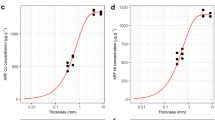Abstract
Environmental samples are extremely diverse but share a tendency for heterogeneity and complexity. This heterogeneity poses methodological challenges when investigating biogeochemical processes. In recent years, the development of analytical tools capable of probing element distribution and speciation at the microscale have allowed this challenge to be addressed. Of these available tools, laterally resolved synchrotron techniques such as X-ray fluorescence mapping are key methods for the in situ investigation of micronutrients and inorganic contaminants in environmental samples. This article demonstrates how recent advances in X-ray fluorescence detector technology are bringing new possibilities to environmental research. Fast detectors are helping to circumvent major issues such as X-ray beam damage of hydrated samples, as dwell times during scanning are reduced. They are also helping to reduce temporal beamtime requirements, making particularly time-consuming techniques such as micro X-ray fluorescence (μXRF) tomography increasingly feasible. This article focuses on μXRF mapping of nutrients and metalloids in environmental samples, and suggests that the current divide between mapping and speciation techniques will be increasingly blurred by the development of combined approaches.

Tricolour maps of elemental distributions in a barley grain: Zn (red), Compton (green) and Mn (blue)



Similar content being viewed by others
References
Hesterberg D, Duff MC, Dixon JB, Vepraskas MJ (2010) X-ray microspectroscopy and chemical reactions in soil microsites. J Environ Qual. doi:10.2134/jeq2010.0140
Sparks DL (2001) Elucidating the fundamental chemistry of soils: past and recent achievements and future frontiers. Geoderma 100:303–319
Lobinski R, Moulin C, Ortega R (2006) Imaging and speciation of trace elements in biological environment. Biochimie 88:1591–1604
McRae R, Bagchi P, Sumalekshmy S, Fahrni CJ (2009) In situ imaging of metals in cells and tissues. Chem Rev 109:4780–4827
Lombi E, Scheckel KG, Kempson IM (2010) In situ analysis of metal(loid)s in plants: state of the art and artefacts. Environ Exp Bot. doi:10.1016/j.envexpbot.2010.04.005
Pickering IJ, Prince RC, Salt DE, George GN (2000) Quantitative, chemically specific imaging of selenium transformation in plants. Proc Nat Acad Sci USA 97:10717–10722
Denecke MA, Somogyi A, Janssens K, Simon R, Dardenne K, Noseck U (2007) Microanalysis (micro-XRF, micro-XANES, and micro-XRD) of a tertiary sediment using microfocused synchrotron radiation. Microsc Microanal 13:165–172
de Jonge MD, Vogt S (2010) Hard X-ray fluorescence tomography—an emerging tool for structural visualization. Curr Opin Struck Biol 20:606–614
Bleuet P, Lemelle L, Tucoulou R, Gergaud P, Delette G, Cloetens P, Susini J, Simionovici A (2010) 3D chemical imaging based on a third generation synchrotron source. Trends Anal Chem 29:518–527
Silversmit G, Vekemans B, Nikitenko S, Schmitz S, Schoonjans T, Brenker FE, Vincze L (2010) Spatially resolved 3D micro-XANES by a confocal detection scheme. Phys Chem Chem Phys 12:5653–5659
Mihucz VG, Silversmit G, Szalóki I, De Samber B, Schoonjans T, Tatára E, Vincze L, Virág I, Yao J, Záray G (2010) Removal of some elements from washed and cooked rice studied by inductively coupled plasma mass spectrometry and synchrotron based confocal micro-X-ray fluorescence. Food Chem 121:290–297
Scheckel KG, Lombi E, Rock SA, McLaughlin MJ (2004) In vivo synchrotron study of thallium speciation and compartmentation in lberis intermedia. Environ Sci Technol 38:5095–5100
Tappero R, Peltier E, Grafe M, Heidel K, Ginder-Vogel M, Livi KJT, Rivers ML, Marcus MA, Chaney RL, Sparks DL (2007) Hyperaccumulator Alyssum murale relies on a different metal storage mechanism for cobalt than for nickel. New Phytol 175:641–654
Kirkham R, Dunn PA, Kucziewski A, Siddons DP, Dodanwela R, Moorhead G, Ryan CG, De Geronimo G, Beuttenmuller R, Pinelli D, Pfeffer M, Davey P, Jensen M, Paterson D, de Jonge MD, Kusel M, McKinlay J (2010) The Maia spectroscopy detector system: engineering for integrated pulse capture, low-latency scanning and real-time processing. AIP Conf Ser 1234:240
Ryan CG, Siddons DP, Moorhead G, Kirkham R, De Geronimo G, Etschmann BE, Dragone A, Dunn PA, Kuczewski A, Davey P, Jensen M, Ablett JM, Kuczewski J, Hough R, Paterson D (2009) High-throughput X-ray fluorescence imaging using a massively parallel detector array, integrated scanning and real-time spectral deconvolution. J Phys Conf Ser 186:012013
Ryan CG, Siddons DP, Kirkham R, Dunn PA, Kuczewski A, Moorhead G, De Geronimo G, Paterson DJ, de Jonge MD, Hough RM, Lintern MJ, Howard DL, Kappen P, Cleverley J (2010) The new Maia detector system: methods for high definition trace element imaging of natural material. AIP Conf Ser 1221:9–17
Ryan CG (2000) Quantitative trace element imaging using PIXE and the nuclear microprobe. Internat J Imag Syst Technol 11:219–230
Ryan CG, Kirkham R, Hough RM, Moorhead G, Siddons DP, de Jonge MD, Paterson DJ, De Geronimo G, Howard DL, Cleverley JS (2010) Elemental X-ray imaging using the Maia detector array: the benefits and challenges of large solid-angle. Nucl Instrum Methods A 619:37–43
Rivers M (2010) 4,000 spectra or 4,000,000 ROIs per second: EPICS support for high-speed digital X-ray spectroscopy with the XIA xMap. In: 10th Int Conf on X-ray Microscopy, Chicago, IL, USA, 15–20 Aug 2010 (see also http://cars9.uchicago.edu/software/epics/dxp.html for DXP 3.0 release; accessed 3 Dec 2010)
Cakmak I (2008) Enrichment of cereal grains with zinc: agronomic or genetic biofortification? Plant Soil 302:1–17
Lombi E, Scheckel KG, Pallon J, Carey AM, Zhu YG, Meharg AA (2009) Speciation and distribution of arsenic and localization of nutrients in rice grains. New Phytol 184:193–201
Takahashi M, Nozoye T, Kitajima N, Fukuda N, Hokura A, Terada Y, Nakai I, Ishimaru Y, Kobayashi T, Nakanishi H, Nishizawa NK (2009) In vivo analysis of metal distribution and expression of metal transporters in rice seed during germination process by microarray and X-ray fluorescence imaging of Fe, Zn, Mn, and Cu. Plant Soil 325:39–51
Lombi E, Smith E, Hansen TH, Paterson D, de Jonge MD, Howard DL, Persson DP, Husted S, Ryan C, Schjoerring JK (2011) Megapixel imaging of (micro)nutrients in mature barley grains. J Exp Bot 62:273–282
Hettiarachchi GM, Scheckel KG, Ryan JA, Sutton SR, Newville M (2006) μ-XANES and μ-XRF investigations of metal binding mechanisms in biosolids. J Environ Qual 35:342–351
Diaz J, Ingall E, Paterson D, de Jonge M, Rau C, Brandes JA (2008) Marine polyphosphate: a key player in geologic phosphorus sequestration. Science 320:652
Etschmann BE, Ryan CG, Brugger J, Kirkham R, Hough RM, Moorhead G, Siddons DP, De Geronimo G, Kuczewski A, Dunn P, Paterson D, de Jonge M, Howard DL, Davey P, Jensen M (2010) Reduced as components in highly oxidized environments: evidence from full spectral XANES imaging using the Maia massively parallel detector. Am Mineral 95:884
de Jonge MD, Holzner C, Baines SB, Twining BS, Ignatyev K, Diaz J, Howard DL, Miceli A, McNulty I, Jacobsen CJ (2010) Quantitative 3-D elemental microtomography of whole Cyclotella meneghiniana at 400-nm resolution. Proc Natl Acad Sci USA 107:15676–15680
Kak AC, Slaney M (1988) Principles of computerized tomographic imaging. IEEE Press, New York
Hegerl R, Hoppe W (1976) Influence of electron noise on three-dimensional image reconstruction. Z Naturfors A J Phys Sci 31:1717–1721
Kim SA, Punshon T, Lanzirotti A, Li LT, Alonso JM, Ecker JR, Kaplan J, Guerinot ML (2006) Localization of iron in Arabidopsis seed requires the vacuolar membrane transporter VIT1. Science 314:1295–1298
Carey AM, Scheckel KG, Lombi E, Newville M, Choi Y, Norton GJ, Charnock JM, Feldmann J, Price AH, Meharg AA (2010) Grain unloading of arsenic species in rice. Plant Physiol 152:309–319
Grieger KD, Hansen SF, Baun A (2009) The known unknowns of nanomaterials: describing and characterizing uncertainty within environmental, health and safety risks. Nanotoxicol 3:1–17
Acknowledgements
The authors would like to thank Mark Rivers (University of Chicago) and Stefan Vogt (Argonne National Laboratory) for the discussion of developments at the Advanced Photon Source, Argonne, IL, USA. Some of the research presented here was undertaken on the X-ray fluorescence microscopy beamline at the Australian Synchrotron, Victoria, Australia. Further synchrotron installations of Maia are anticipated; for more information, please contact C.G.R. (chris.ryan@csiro.au). E.L. gratefully acknowledges financial support by FT100100337 (Australian Research Council Future Fellowship).
Author information
Authors and Affiliations
Corresponding author
Rights and permissions
About this article
Cite this article
Lombi, E., de Jonge, M.D., Donner, E. et al. Trends in hard X-ray fluorescence mapping: environmental applications in the age of fast detectors. Anal Bioanal Chem 400, 1637–1644 (2011). https://doi.org/10.1007/s00216-011-4829-2
Received:
Revised:
Accepted:
Published:
Issue Date:
DOI: https://doi.org/10.1007/s00216-011-4829-2




